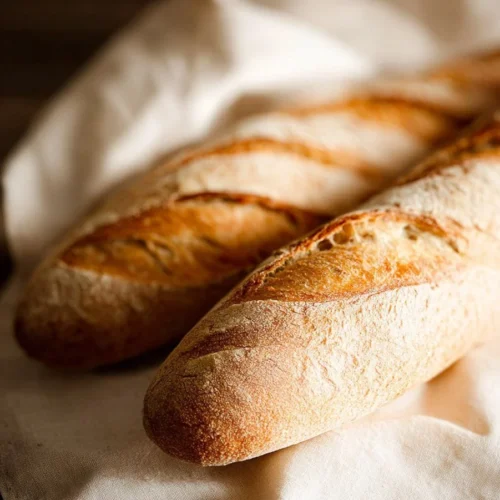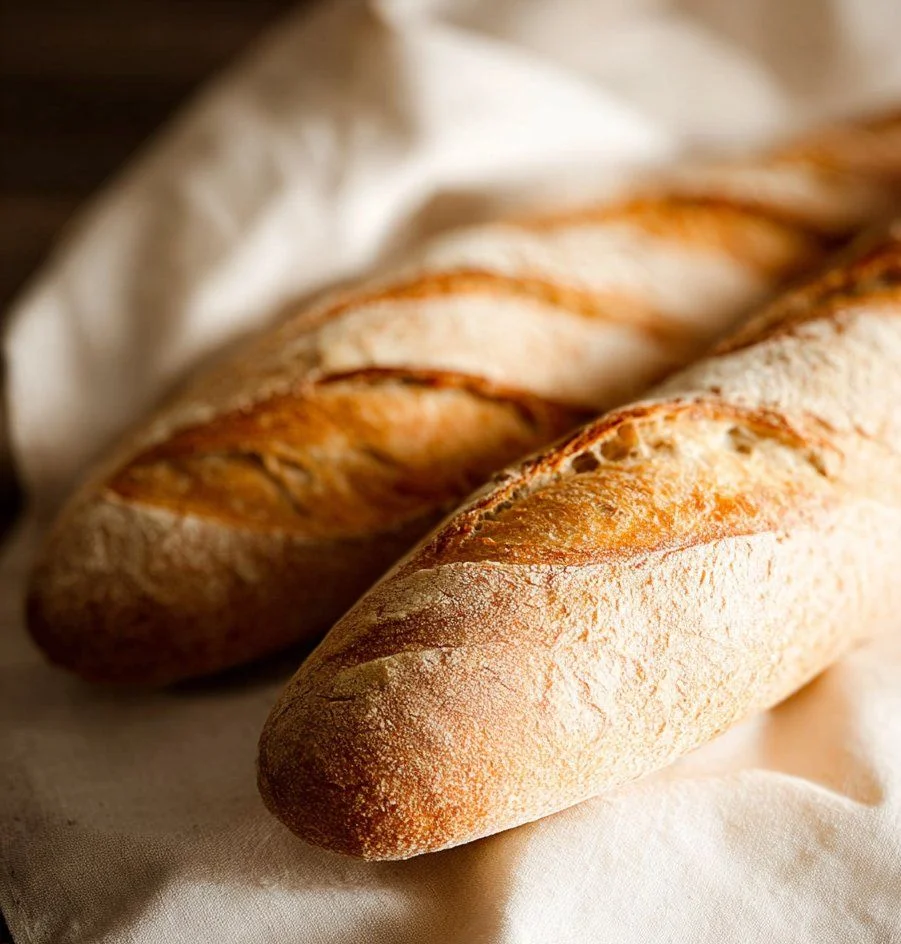There’s something magical about the aroma of fresh French bread wafting through your kitchen. This classic loaf, with its golden crust and soft, airy interior, embodies a culinary tradition that dates back centuries in France. French bread is not just a staple but a beloved embodiment of comfort and simplicity, serving as the perfect accompaniment to various meals or even as a standalone delight.
Why We Love This French Bread Recipe
What sets this French bread recipe apart is its perfect blend of simplicity and flavor. The ingredients are straightforward, readily available, and the process allows you to engage with the dough in a way that’s satisfying and fun. Because French bread doesn’t require any special equipment aside from a stand mixer and a baking tray, you can whip it up right in your own kitchen. Not to mention, the satisfaction of pulling a freshly baked loaf from the oven is unmatched. Its versatility will inspire you to pair it with various dishes, making it an essential addition to your recipe collection.
Ingredients about French Bread
To whip up a scrumptious loaf of French bread, you’ll need the following ingredients:
- Warm water: 2 1/4 cups (112° to 115°)
- Sugar: 2 teaspoons
- Active yeast: 1 packet
- Sea salt: 2 teaspoons
- Unsalted butter: 2 teaspoons, softened
- Bread flour: 5 cups
These basic yet essential components come together to create a loaf that is not only flavorful but also remarkably satisfying to make.
How to Make French Bread Directions
Creating the perfect French bread involves several straightforward steps. First, start by adding half of the warm water to the bowl of your stand mixer. Mix in the sugar and active yeast. Whisk gently, then let this mixture stand for about 5 to 7 minutes, allowing the yeast to activate and form a frothy raft on the surface.
Next, incorporate the remaining water, along with the salt, softened butter, and bread flour into the mixer. With the dough hook attachment, knead the ingredients together for approximately 8 to 10 minutes. The goal is to achieve a slightly sticky dough that pulls away from the sides of the bowl yet remains supple to the touch.
Once your dough is ready, cover the bowl with plastic wrap and place it in a warm area for about 90 minutes. During this time, the dough should double in size, thanks to the yeast working its magic. After the proofing period, punch down the dough gently to release any trapped air, then transfer it to a floured surface. Knead it lightly for 1 to 2 minutes to develop the gluten further.
Next, you will divide the dough into either four equal pieces for standard loaves or three for thicker loaves. Shape each piece into an oval by folding it over and pinching the seams together securely. Roll each piece into a 12- to 16-inch long loaf, then transfer them to a parchment-lined tray. Make sure to cover the dough with a towel and let it proof again in a warm location for an additional 60 minutes.
While the dough is undergoing its final proof, preheat your oven to 425°F. Placing a pan of water in the bottom rack of the oven will create steam, resulting in a beautifully crisp crust. Once the loaves have risen sufficiently, score them with a sharp knife to allow for expansion during baking. You can also mist or brush the tops with water for a lovely finish.
Finally, bake your bread in the preheated oven for about 22 to 25 minutes, until the tops are golden brown and have a satisfying crust. Once done, remove the bread from the oven and let it cool on a wire rack. When ready to enjoy, slice it up and delve into the delightful flavors of homemade French bread.
How to Serve French Bread
Serving French bread provides endless possibilities. You can slice it thick and serve it warm with a generous spread of butter or olive oil for a heavenly treat. Its crusty exterior makes it perfect for dipping into soups or stews, enhancing your meal with its rich texture. Use it to create simple sandwiches filled with fresh vegetables, grilled meats, or even a spread of cheese for a delightful brunch option.
For a more casual affair, consider preparing a classic French toast by soaking slices in a mixture of eggs and milk, then pan-frying until golden brown. Alternatively, top sliced baguettes with a medley of your favorite ingredients, such as tomatoes, basil, and mozzarella, for a quick and refreshing bruschetta.
The charm of French bread lies in its versatility; there’s no wrong way to savor it. Pair it with salads, pate, or your favorite spreads, and you’ll discover that this humble loaf elevates any meal to new heights.
Expert Tips: French Bread
When it comes to mastering French bread, a few expert tips can significantly improve your results. First, ensure that your yeast is fresh by checking the expiration date on the packet. Using warm water is crucial, as too hot water can kill the yeast, preventing the dough from rising.
Utilize a kitchen thermometer if unsure about the temperature; the ideal range for activating yeast is between 112° and 115°F. When kneading the dough, aim for a slightly sticky texture rather than adding too much flour, as this can impact the final texture of your bread.
Another tip is to be patient with the proofing times. Allowing the dough to double in size is essential for developing flavor and texture. When scoring the loaves, be generous; this promotes a nice oven spring, resulting in a rustic appearance.
If you’re looking for a more pronounced crust, consider using a baking stone, which helps distribute heat evenly. Lastly, every oven is different; keep a close eye on your loaves during the last few minutes of baking to ensure they reach the perfect golden hue without burning.
How to Store French Bread
To keep your homemade French bread fresh, let it cool completely after baking. Once cooled, wrap the bread in a clean kitchen towel or place it in a paper bag to retain its crusty exterior. If you plan to enjoy it within a couple of days, storing it at room temperature is sufficient.
For longer storage, consider freezing the bread. Slice the loaves and place them in a freezer-safe bag, removing as much air as possible to prevent freezer burn. When you’re ready to enjoy the bread, simply take out the desired number of slices and let them thaw at room temperature. You can also pop them in the toaster or oven to refresh the crust, bringing that fresh-baked goodness back to life.
Variation of French Bread
While classic French bread is a delightful treat in itself, experimenting with variations can lead to exciting new flavors. For a touch of sweetness, consider adding a tablespoon of honey or a handful of dried fruits, such as raisins or cranberries. This addition can transform your French bread into a delightful breakfast option or snack.
Herbed French bread is another enjoyable twist. Incorporate dried herbs such as rosemary, thyme, or Italian seasoning into your dough during the mixing stage. This infusion will impart a fragrant aroma and enhance the flavor profile of the bread, making it perfect for pairing with your favorite soups or salads.
You might also explore whole wheat flour or a blend of all-purpose flour for a heartier texture. Additionally, adding seeds such as sesame or poppy seeds can give the crust an exciting crunch and nuttiness. Experimenting with these variations allows you to cater to your taste preferences while enjoying homemade French bread in different forms.
FAQ Section
What is the best way to bake French bread?
The best way to bake French bread includes using steam in the oven, which creates a crusty exterior. Placing a pan of water in the bottom rack during baking is a great method.
How long does it take to make French bread?
From start to finish, the process of making French bread can take about 3 to 4 hours, including the proofing time. However, much of that time is hands-off, allowing you to attend to other tasks.
Can I make French bread without a stand mixer?
Yes! While a stand mixer makes kneading easy, you can also knead the dough by hand. It may take a bit longer, but the result will be just as delicious.
Is it possible to use all-purpose flour for French bread?
Yes, you can use all-purpose flour instead of bread flour. However, bread flour has a higher protein content, which contributes to a chewier and more structured bread.
What should I do if my dough isn’t rising?
If your dough isn’t rising, it’s possible that your yeast is old or the water temperature was off. Ensure you’re using fresh yeast and warm water within the appropriate range to avoid this issue.

French Bread
Ingredients
- 2 ¼ cups warm water (112° to 115° F)
- 2 teaspoons sugar
- 1 packet active yeast
- 2 teaspoons sea salt
- 2 teaspoons unsalted butter softened
- 5 cups bread flour
Instructions
- In the bowl of a stand mixer, combine half of the warm water with sugar and yeast. Whisk gently and let sit for 5 to 7 minutes to activate.
- Add the remaining water, salt, softened butter, and bread flour to the mixer. Using the dough hook, knead for 8 to 10 minutes until a slightly sticky dough forms.
- Cover the bowl with plastic wrap and let it rise in a warm area for about 90 minutes, until doubled in size.
- Punch down the dough gently, transfer to a floured surface, and knead lightly for 1 to 2 minutes.
- Divide the dough into four pieces for standard loaves or three for thicker loaves. Shape each piece into an oval, pinching the seams together.
- Roll each piece into a 12- to 16-inch long loaf and place on a parchment-lined tray. Cover with a towel and let rise for another 60 minutes.
- Preheat your oven to 425°F (220°C) and place a pan of water on the bottom rack for steam.
- Score the tops of the loaves with a sharp knife and mist or brush with water.
- Bake for 22 to 25 minutes until golden brown and crusty. Let cool on a wire rack.
Send me this recipe!
Just enter your email below and get it sent straight to your inbox!


